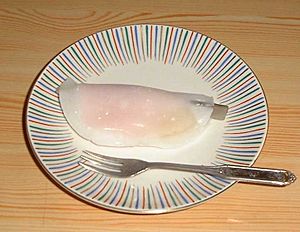Hanabiramochi facts for kids
 |
|
| Type | Wagashi |
|---|---|
| Place of origin | Japan |
| Main ingredients | Mochi, miso, Gyūhi, burdock |
Hanabiramochi (葩餅) is a special Japanese sweet. People usually eat it at the start of a new year. It is also served during the first tea ceremony of the new year. This sweet is a type of wagashi, which means traditional Japanese sweets.
Contents
What is Hanabiramochi?
The name "hanabiramochi" means "flower petal mochi". Mochi is a chewy Japanese rice cake. This sweet looks like a flower petal.
History of Hanabiramochi
The first version of Hanabiramochi was called Hishihanabira. The Imperial family, which is Japan's royal family, ate it. They enjoyed it at special events at the beginning of the year.
Hanabiramochi as we know it today was first made during the Meiji Era. This was a time in Japanese history from 1868 to 1912. Now, it is a well-known New Year wagashi (Japanese sweet).
How Hanabiramochi Looks
The exact shape of hanabiramochi follows old traditions. The outside is made of white mochi. It is flat and round. This mochi is folded over to make a half-circle shape.
Colors and Fillings
A pink color must show through the white mochi in the middle. This pink fades to white at the edges. Unlike a daifuku (another type of mochi sweet), the mochi does not completely close around the filling.
Inside the hanabiramochi is a layer of anko. This is a sweet bean paste. It is often made from sweetened mung beans, which are light in color.
The Burdock Root
In the very center, there is a thin strip of sweetly flavored gobo. Gobo is a type of burdock root. This strip sticks out from the mochi on both sides.
Meaning of Hanabiramochi
Every part of the hanabiramochi has a special meaning.
New Year Symbolism
The red color showing through the white mochi is perfect for New Year celebrations. It also looks like the Japanese apricot or plum (ume) blossom. This flower stands for purity, never giving up, and new beginnings. These are all important ideas for the New Year.
Long Life Wish
The gobo (burdock root) inside the sweet represents pressed ayu. The ayu is a type of fish found only in East Asia. Having the gobo in the sweet is like a wish for a long life.
See also
 In Spanish: Hanabiramochi para niños
In Spanish: Hanabiramochi para niños

